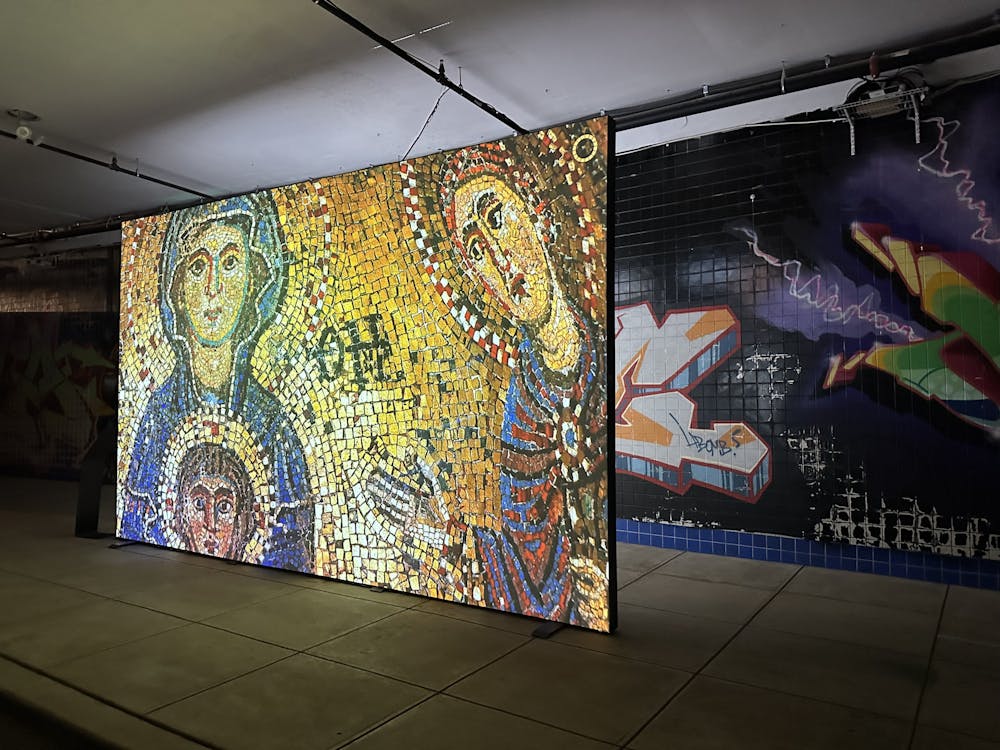“Mosaico Italian code of a timeless art” is the Dupont Underground’s latest exhibit, in collaboration with the Embassy of Italy, running until Feb. 2.
Decorating cathedral ceilings, palace walls and the Mediterranean seafloor, the ancient artistic tradition of mosaics, or the art of creating images or patterns out of small pieces of glass, clay and stone, has a rich, territorial history in Italy and Sicily.
“Mosaico” features six stations of Italian Mosaic that guide viewers through the geographical history of the art form and highlights pieces from the Farnesina Collection, owned by and housed in the Italian Ministry of Foreign Affairs and International Cooperation.
Each station featured in the exhibit highlights a different geographical area, including Rome, Pompeii, Aquileia, Ravenna, Palermo/Monreale, Piazza Monreale and Baiae.
The exhibit starts with Area 01, which features Rome and Pompeii, where mosaics from ancient Basicallas and the wealthy House of the Faun introduce visitors to the sacred art form.
Area 02 moves to the Roman city of Aquilei, and highlights mosaics created after the reign of the Edict of Constantine, as Area 03 takes visitors through the last location of mainland Italy, Ravenna and its Byzantine influences.
Areas 04 and 05 feature mosaics from Palermo, Monreale and Pizza Armenia, all found on the island of Sicily. The exhibit highlights shifts in geographical and territorial differences in mosaic craftsmanship between Sicily and mainland Italy and the influences of the Roman Empire on the country as a whole.
The “Mosaico” exhibit ends with Area 06, and an exploration of the submerged city of Baiae. This station features a short film that shows divers uncovering Sicilian mosaics concealed on the seafloor of the Mediterranean, by removing the sand hiding them by hand.
The exhibit’s venue, the Dupont Underground, is a fully transformed 15,000-square-foot abandoned area under Dupont Circle that now functions as an exhibit space for the non-profit art organization. In the 1940s, the tunnels were used by streetcars that shuttled residents from one side of Connecticut Avenue to the other, as a way to limit the severe traffic in Dupont Circle.
The concrete tunnels of the Dupont Underground are now covered in vibrant murals and graffiti, making it a unique, unconventional spot to host contemporary art exhibits.
The juxtaposition between the graffiti on the abandoned walls of the Dupont Underground and the beautiful, intricate Italian mosaic emphasizes the beauty of both the venue and the current exhibit.
“Mosaico” also utilizes the unique space in the Dupont Underground by breaking free of a typical museum format. Using both large digital screens and double-sided animated projections instead of static images allows viewers to get up close and examine the mosaics’ intricate details.
The exhibit ends on an optimistic note, hinting that as more of the sand on the Mediterranean seafloor is removed, more Sicilian mosaic artifacts and pieces from the submerged Roman cities are bound to be uncovered.
The Dupont Underground will host a concert full of Italian poetry and music to accompany the “Mosaico” exhibit called Hidden Gems: A Mosaic of Italian Art, Words, and Songs on Nov. 15 and Dec. 11 in collaboration with New Music-Theater.
Tickets for the Dupont Underground’s “Mosaico” exhibit can be purchased here and are discounted for students.
This article was edited by Jessica Ackerman, Marina Zaczkiewicz and Abigail Turner. Copy editing done by Luna Jinks, Emma Brown and Ariana Kavoossi.





